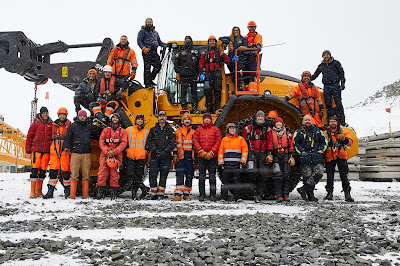New faces after 7 months of isolation
Our winter began on 23rd March when the ship made its final call and departed from Rothera with the outgoing wintering team. This was to be the last contact with the outside world for seven months. What was left at Rothera Research station was 23 personnel and the penguins. During the harsh winter months, our team continued the collection of scientific data whilst keeping the station running.
The 2021 wintering team of 23 people on our first day of winter
Photo credit- Ed Luke
For seven months, I have seen the same people every day with no influx of new faces. Planes and ships cannot access our station for a large proportion of the year. During the austral winter months, the Antarctic ocean freezes preventing shipping and during this time the continent almost doubles in size with the increase of sea ice" Heavy snow fall and cycles of melting and thawing results in ice accumulation on the runway, and together with minimal daylight hours, means aircrafts cannot land.
During our winter, we have experienced many days of gale force winds and heavy precipitation completely burying the entrances to many buildings. Below is a photo of the Bonner laboratory (where I work), you can't see our main door because it is completely buried under a windscoop. This is a natural feature resulting from wind brushing up against a surface (ie. buildings, ice) and calving a shape reminiscent of an ice cream scoop.
Where is the entrance door to the Bonner Laboratory ?
Similarly, my office windows need to be regularly dug out as all light is completely obstructed! On bad weather days, it can often feel as if I am in a cave. In order to transfer dive equipment from the dive store located in the Bonner Laboratory onto our boats, the diving officers have also taken great pride in maintaining and sculpting snow steps to ferry equipment out of the snow scoop. We load our diving equipment onto sledges and cart our kit through the snow.
Mike (dive officer) digging the dive door steps
The dive door 'igloo'. I took this photo this weekend to show that the snow is now at roof level!
Ryan (marine assistant) hauling the diving kit to the boat shed.
And it continues! The local refuge area that I have spoken about in past blogs, the caboose, was completely buried under snow. A station wide effort was needed to hand dig (with the exception of the use of a handheld snow blower) a large shipping container that had been submerged by ~3m of snow.
The vehicles team have been busy clearing the runway since September, removing the snow and exposing a ice layer of 8cm average depth. The thick layer of ice is caused as a result of snow accumulation that is melting and freezing throughout the winter. These freeze-thaw cycles have been particularly persistent this year and a huge effort was needed to help melt the ice in the form of digging melt water channels, manually axing the ice layer and gritting the surface.
The 5th of October marked the arrival of a twin otter plane that brought with it the first sightings of other human life forms the wintering team has seen(!), Covid vaccines and the first fresh fruit and vegetables we had had for 7 months. It has been noted by the new people that the wintering team are extremely pale.. and there's me thinking everyone was just tanned after a UK summer.
The Covid vaccination bought in by a Twin Otter aircraft
Photo credit- Matthew Phillips
Never has a cucumber tasted so good. Our last supply of fresh fruit and vegetables was from the ships last call in March. We ran out of salad and fruit within the first month and the final carrots and lemon were sacrificed in July. You can watch this video our electronics engineer (Jas) made of the Covid vaccine arrival. It also made headline BBC news.
Last month officially marked the end of ice diving. Our ice holes were blow away with the deteriorating sea ice which is no longer held fast to the land. After taking care to maintain them and keep them free of ice, it was disappointing to see them go. Fingers crossed for a better sea ice year in 2022.
Jack (dive officer) and myself clearing the frozen surface layer from the ice holePhoto credit- Andy Hood
With the increasing daylight, we transition into Spring. Water productivity is increasing, sea ice is melting and Weddell seals have been having pups on the remaining ice. It's an absolute delight to follow the movement of the mum and pup within just a stone throw of the station.
A Weddell seal mum and pup



























Hi Nadia. Well done you for making it through the winter! We’ll be on the peninsula on about November 7th. Contact me soon if you want as we leave home tomorrow.
ReplyDelete